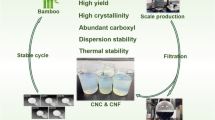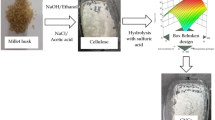Abstract
An innovative system for isolating nanocellulose was established that uses Ni(NO3)2 transition metal salt without the assistance of mechanical disintegrations or mineral acid and was compared with the classic production by tedious acid hydrolysis. Optimization study on Ni(II)-catalyzed hydrolysis of cellulose isolated from oil palm (Elaeis guineensis) empty fruit bunch (OPEFB) towards nanocellulose yield was investigated. Response surface methodology-central composite design was used to design and optimize the experiments with three operating parameters: pH of Ni(NO3)2 (pH 2–4), reaction time (20‒100 min) and reaction temperature (25‒65 °C). The present study indicated that the nanocellulose yield as high as 81.37% was achieved under hydrolysis conditions of pH 3, 58 °C within 58 min. At the optimum conditions, the OPEFB derived nanocellulose rendered high crystallinity of 91.1% and excellent thermal stability of 341 °C. Evidence of the successful isolation of nanocellulose was proven by HRTEM observation revealing fibrils formed the long and interconnected network-like structure with the average width of 41.1 ± 1.6 nm and several micrometers in length, which resulted in high aspect ratio. Thus, the obtained nanocellulose via Ni(II)-catalyzed hydrolysis has numerous potential applications and represent a green alternative for the treatment of OPEFB. This study provided a facile high yield procedure for the production of nanocellulose with similar characteristics to traditional nanocellulose, which was significant to the commercialization of nanocellulose.









Similar content being viewed by others
References
Habibi Y, Lucia LA, Rojas OJ (2010) Cellulose nanocrystals: chemistry, selfassembly, and applications. Chem Rev 110:3479–3500
Al-Dulaimi AA, Wanrosli WD (2016) Isolation and characterization of nanocrystalline cellulose from totally chlorine free oil palm empty fruit bunch pulp. J Polym Environ 25:192–202
Rohaizu R, Wanrosli WD (2017) Sono-assisted TEMPO oxidation of oil palm lignocellulosic biomass for isolation of nanocrystalline cellulose. Ultrason Sonochem 34:631–639
Chen YW et al. (2018) Novel superabsorbent cellulose-based hydrogels: present status, synthesis, characterization, and application prospects. In: M Ibrahim, H Mondal (eds) Cellulose-based superabsorbent hydrogels. Springer, New York, p. 1–41
Chen YW, Lee HV (2018) Revalorization of selected municipal solid wastes as new precursors of “green” nanocellulose via a novel one-pot isolation system: a source perspective. Int J Biol Macromol 107:78–92
Deepa B et al (2015) Utilization of various lignocellulosic biomass for the production of nanocellulose: a comparative study. Cellulose 22(2):1075–1090
Cowie J et al. (2014) Market projections of cellulose nanomaterial-enabled products–part 2: volume estimates. TAPPI J 13(6):57–69
de KCC Benini et al. (2018) Preparation of nanocellulose from Imperata brasiliensis grass using Taguchi method. Carbohydr Polym 192:337–346
Chen YW et al. (2018) Pyrus pyrifolia fruit peel as sustainable source for spherical and porous network based nanocellulose synthesis via one-pot hydrolysis system. Int J Biol Macromol 123:1305–1319
Lee HV, Hamid SB, Zain SK (2014) Conversion of lignocellulosic biomass to nanocellulose: structure and chemical process. ScientificWorldJournal 2014:631013
Roman M, Winter W (2004) Effect of sulfate groups from sulfuric acid hydrolysis on the thermal degradation behavior of bacterial cellulose. Biomacromolecules 5:1671–1677
Yu H et al (2013) Facile extraction of thermally stable cellulose nanocrystals with a high yield of 93% through hydrochloric acid hydrolysis under hydrothermal conditions. J Mater Chem A 1(12):3938–3944
Kaushik M, Moores A (2016) Review: nanocelluloses as versatile supports for metal nanoparticles and their applications in catalysis. Green Chem 18(3):622–637
Thulluri C et al (2013) The effect of assorted pretreatments on cellulose of selected vegetable waste and enzymatic hydrolysis. Biomass Bioenergy 49:205–213
Chen You W, Lee HV (2018) Recent progress in homogeneous Lewis acid catalysts for the transformation of hemicellulose and cellulose into valuable chemicals, fuels, and nanocellulose. Rev Chem Eng. https://doi.org/10.1515/revce-2017-0071
Kamireddy SR et al (2013) Effects and mechanism of metal chloride salts on pretreatment and enzymatic digestibility of corn stover. Ind Eng Chem Res 52(5):1775–1782
Zhang Y et al (2015) A green and efficient technology for the degradation of cellulosic materials: structure changes and enhanced enzymatic hydrolysis of natural cellulose pretreated by synergistic interaction of mechanical activation and metal salt. Biores Technol 177:176–181
Lu Z et al (2013) Preparation, characterization and optimization of nanocellulose whiskers by simultaneously ultrasonic wave and microwave assisted. Biores Technol 146:82–88
Jiang C (2014) Hydrolytic hydrogenation of cellulose to sugar alcohols by nickel salts. Cellul Chem Technol 48(1–2):75–78
Huo Z et al (2014) Selective conversion of glucose into lactic acid with transition metal ions in diluted aqueous NaOH solution. ACS Sustain Chem Eng 2(12):2765–2771
Boufi S, Chaker A (2016) Easy production of cellulose nanofibrils from corn stalk by a conventional high speed blender. Ind Crops Prod 93:39–47
Alila S et al (2013) Non-woody plants as raw materials for production of microfibrillated cellulose (MFC): a comparative study. Ind Crops Prod 41:250–259
Chen YW et al (2016) Production of new cellulose nanomaterial from red algae marine biomass Gelidium elegans. Carbohyd Polym 151:1210–1219
Chen YW, Lee HV, Abd Hamid SB (2017) Facile production of nanostructured cellulose from Elaeis guineensis empty fruit bunch via one pot oxidative-hydrolysis isolation approach. Carbohyd Polym 157:1511–1524
Carrier M et al (2011) Thermogravimetric analysis as a new method to determine the lignocellulosic composition of biomass. Biomass Bioenerg 35(1):298–307
Moriana R, Vilaplana F, Ek M (2016) Cellulose nanocrystals from forest residues as reinforcing agents for composites: a study from macro- to nano-dimensions. Carbohyd Polym 139:139–149
Lee HV et al (2011) Process optimization design for jatropha-based biodiesel production using response surface methodology. Fuel Process Technol 92(12):2420–2428
Chen YW, Lee HV, Abd Hamid SB (2017) Investigation of optimal conditions for production of highly crystalline nanocellulose with increased yield via novel Cr(III)-catalyzed hydrolysis: response surface methodology. Carbohyd Polym 178:57–68
Onukwuli DO et al (2017) Optimization of biodiesel production from refined cotton seed oil and its characterization. Egypt J Pet 26(1):103–110
Kim J-H et al (2015) Review of nanocellulose for sustainable future materials. Int J Precis Eng Manuf Green Technol 2(2):197–213
Li J et al (2013) Enhancement of cellulose acid hydrolysis selectivity using metal ion catalysts. Curr Org Chem 17(15):1617–1623
Zhao J et al (2011) The enhancement of pretreatment and enzymatic hydrolysis of corn stover by FeSO4 pretreatment. Biochem Eng J 56(3):158–164
Karim MZ et al (2014) Statistical optimization for acid hydrolysis of microcrystalline cellulose and its physiochemical characterization by using metal ion catalyst. Materials 7(10):6982–6999
Chen W et al (2011) Individualization of cellulose nanofibers from wood using high-intensity ultrasonication combined with chemical pretreatments. Carbohyd Polym 83(4):1804–1811
Tan XY, Abd Hamid SB, Lai CW (2015) Preparation of high crystallinity cellulose nanocrystals (CNCs) by ionic liquid solvolysis. Biomass Bioenerg 81:584–591
Xiang Q, Kim JS, Lee YY (2003) A comprehensive kinetic model for dilute-acid hydrolysis of cellulose. Appl Biochem Biotechnol 106(1):337–352
Chen YW et al (2017) Easy fabrication of highly thermal-stable cellulose nanocrystals using Cr(NO3)3 catalytic hydrolysis system: a feasibility study from macro-to nano-dimensions. Materials 10(1):42
Qiang D et al (2016) Selective hydrolysis of cellulose for the preparation of microcrystalline cellulose by phosphotungstic acid. Cellulose 23(2):1199–1207
Liu Z et al (2017) Extraction, isolation and characterization of nanocrystalline cellulose from industrial kelp (Laminaria japonica) waste. Carbohydrate polymers 173:353–359
Ilyas R, Sapuan S, Ishak M (2018) Isolation and characterization of nanocrystalline cellulose from sugar palm fibres (Arenga Pinnata). Carbohyd Polym 181:1038–1051
Flauzino Neto WP et al (2013) Extraction and characterization of cellulose nanocrystals from agro-industrial residue—soy hulls. Ind Crops Prod 42(0):480–488
Ares-Peón IA et al (2016) Phenolics production from alkaline hydrolysis of autohydrolysis liquors. CyTA-J Food 14(2):255–265
Cherian BM et al (2010) Isolation of nanocellulose from pineapple leaf fibres by steam explosion. Carbohyd Polym 81(3):720–725
Sharma RK, Kumar R, Singh AP (2018) Extraction of cellulose micro-whiskers from rice husk: a greener approach. J Nanosci Nanotechnol 18(5):3702–3708
Abraham E et al (2011) Extraction of nanocellulose fibrils from lignocellulosic fibres: a novel approach. Carbohyd Polym 86(4):1468–1475
Johar N, Ahmad I, Dufresne A (2012) Extraction, preparation and characterization of cellulose fibres and nanocrystals from rice husk. Ind Crops Prod 37(1):93–99
Alemdar A, Sain M (2008) Isolation and characterization of nanofibers from agricultural residues: wheat straw and soy hulls. Biores Technol 99(6):1664–1671
Brito BL et al (2012) Preparation, morphology and structure of cellulose nanocrystals from bamboo fibers. Cellulose 19(5):1527–1536
Dhepe PL, Fukuoka A (2008) Cellulose conversion under heterogeneous catalysis. ChemSusChem 1(12):969–975
Yahya M et al (2018) Reuse of selected lignocellulosic and processed biomasses as sustainable sources for the fabrication of nanocellulose via Ni(II)-catalyzed hydrolysis approach: a comparative study. J Polym Environ 26(7):2825–2844
Li R et al (2009) Cellulose whiskers extracted from mulberry: a novel biomass production. Carbohyd Polym 76(1):94–99
Liu C et al (2016) Properties of nanocellulose isolated from corncob residue using sulfuric acid, formic acid, oxidative and mechanical methods. Carbohyd Polym 151:716–724
Chen YW, Lee HV, Abd Hamid SB (2016) Preparation and characterization of cellulose crystallites via Fe(III)-, Co(II)-and Ni(II)-assisted dilute sulfuric acid catalyzed hydrolysis process. J Nano Res 41:96–109
Chen YW, Lee HV, Hamid SBA (2016) A response surface methodology study: effects of trivalent Cr3 + metal ion-catalyzed hydrolysis on nanocellulose crystallinity and yield. BioResources 11(2):4645–4662
Yahya MB, Lee HV, Hamid SBA (2015) Preparation of nanocellulose via transition metal salt-catalyzed hydrolysis pathway. BioResources 10(4):7627–7639
Sofla MRK et al (2016) A comparison of cellulose nanocrystals and cellulose nanofibres extracted from bagasse using acid and ball milling methods. Adv Nat Sci Nanosci Nanotechnol 7(3):035004
Gibson LJ (2012) The hierarchical structure and mechanics of plant materials. J R Soc Interface 9(76):2749–2766
Sheltami RM et al (2012) Extraction of cellulose nanocrystals from mengkuang leaves (Pandanus tectorius). Carbohyd Polym 88(2):772–779
Yan T, Xu Y, Yu C (2009) The isolation and characterization of lignin of kenaf fiber. J Appl Polym Sci 114(3):1896–1901
Xiang Z et al (2016) A comparison of cellulose nanofibrils produced from Cladophora glomerata algae and bleached eucalyptus pulp. Cellulose 23(1):493–503
Orasugh JT et al (2018) A facile comparative approach towards utilization of waste cotton lint for the synthesis of nano-crystalline cellulose crystals along with acid recovery. Int J Biol Macromol 109:1246–1252
Chen YW, Lee HV, Hamid SBA (2016) Preparation of nanostructured cellulose via Cr(III)-and Mn(II)-transition metal salt catalyzed acid hydrolysis approach. BioResources 11(3):7224–7241
Chen W et al (2014) Comparative study of aerogels obtained from differently prepared nanocellulose fibers. ChemSusChem 7(1):154–161
Chen W et al (2015) Revealing the structures of cellulose nanofiber bundles obtained by mechanical nanofibrillation via TEM observation. Carbohyd Polym 117:950–956
Feng X et al (2015) Extraction and preparation of cellulose nanocrystals from dealginate kelp residue: structures and morphological characterization. Cellulose 22(3):1763–1772
Ishak M et al (2011) Characterization of sugar palm (Arenga pinnata) fibres: tensile and thermal properties. J Therm Anal Calorim 109(2):981–989
Morán JI et al. (2008) Extraction of cellulose and preparation of nanocellulose from sisal fibers. Cellulose 15(1):149–159
Yang H et al (2007) Characteristics of hemicellulose, cellulose and lignin pyrolysis. Fuel 86(12–13):1781–1788
Bondancia TJ et al (2017) A new approach to obtain cellulose nanocrystals and ethanol from eucalyptus cellulose pulp via the biochemical pathway. Biotechnol Progress 33(4):1085–1095
Singh S et al (2017) Microwave-assisted step reduced extraction of seaweed (Gelidiella aceroso) cellulose nanocrystals. Int J Biol Macromol 99:506–510
Deepa B et al (2011) Structure, morphology and thermal characteristics of banana nano fibers obtained by steam explosion. Biores Technol 102(2):1988–1997
Goh KY et al (2016) Individualization of microfibrillated celluloses from oil palm empty fruit bunch: comparative studies between acid hydrolysis and ammonium persulfate oxidation. Cellulose 23(1):379–390
Acknowledgements
The authors are grateful for the financial support by University Malaya: SATU Joint Research Scheme (ST015-2017 and ST012-2018) and RU Grant (RU007C-2017G).
Author information
Authors and Affiliations
Corresponding author
Additional information
Publisher’s Note
Springer Nature remains neutral with regard to jurisdictional claims in published maps and institutional affiliations.
Rights and permissions
About this article
Cite this article
Yahya, M., Chen, Y.W., Lee, H.V. et al. A New Protocol for Efficient and High Yield Preparation of Nanocellulose from Elaeis guineensis Biomass: A Response Surface Methodology (RSM) Study. J Polym Environ 27, 678–702 (2019). https://doi.org/10.1007/s10924-019-01373-7
Published:
Issue Date:
DOI: https://doi.org/10.1007/s10924-019-01373-7




